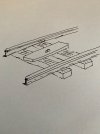Airbuspilot
Registered
Gentlemen
A friend is building a very large G scale garden railway using LGB rolling stock. We have completed laying around half the track, approx 100 meters to date. We have made a concrete foundation with the track currently sitting on top. At this stage there in no intention to ballast the track, that may change with time.
Our plan was to drill the concrete, insert plugs and screw through the track to the plugs. We are in a very hot climate and already expansion is causing visible track movement. My concern is that screwing through t he plastic sleepers may cause cracking and may not stop expansion causing problems.
Can anyone suggest a novel fixing method for hot environments?
Thanks again
Robin
A friend is building a very large G scale garden railway using LGB rolling stock. We have completed laying around half the track, approx 100 meters to date. We have made a concrete foundation with the track currently sitting on top. At this stage there in no intention to ballast the track, that may change with time.
Our plan was to drill the concrete, insert plugs and screw through the track to the plugs. We are in a very hot climate and already expansion is causing visible track movement. My concern is that screwing through t he plastic sleepers may cause cracking and may not stop expansion causing problems.
Can anyone suggest a novel fixing method for hot environments?
Thanks again
Robin


